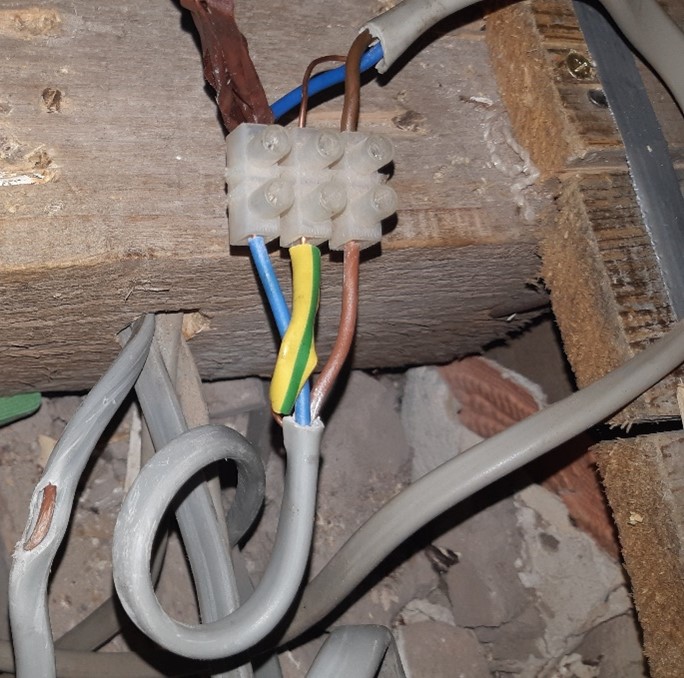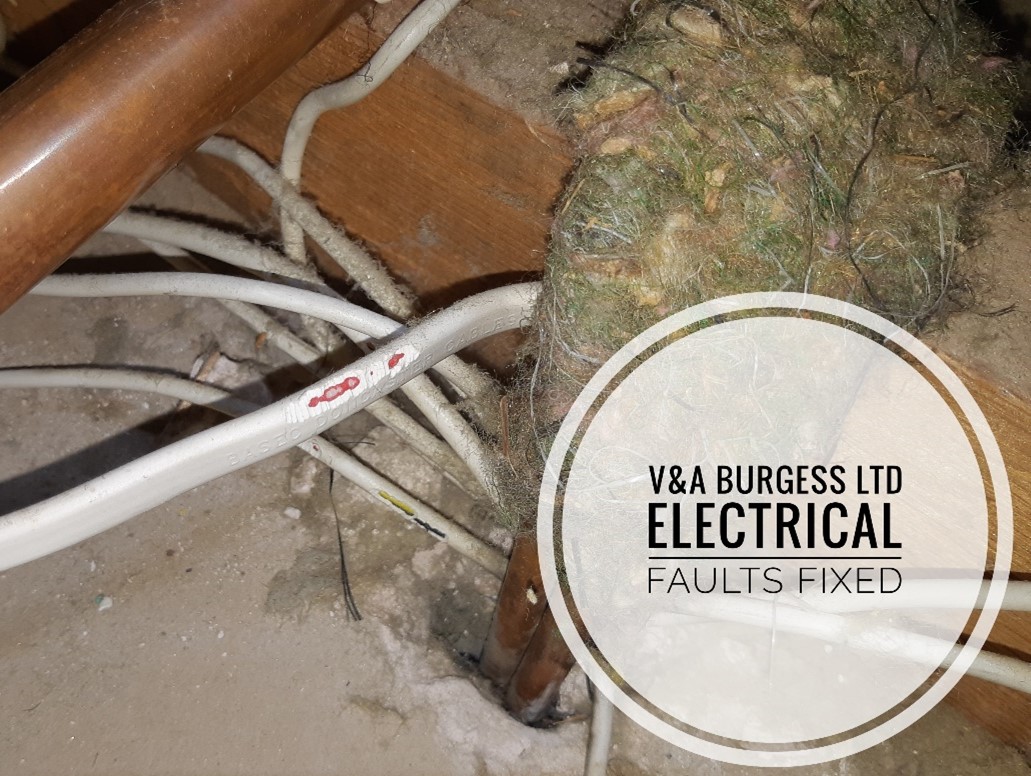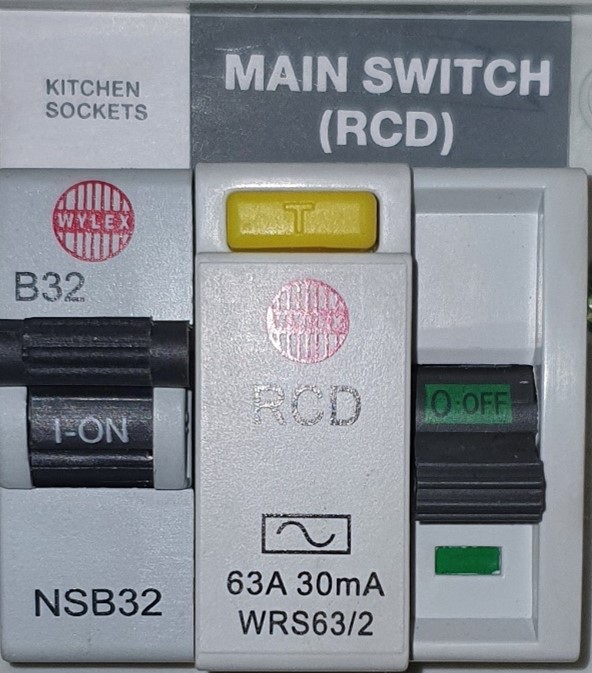
Table of Contents
- Common Causes of Dangerous Wiring
- Signs of Dangerous Wiring
- What are the Consequences of Ignoring Dangerous Wiring?
- The role of certified electricians in ensuring code adherence
- Home Inspection and DIY Maintenance Tips
- Regular inspections of wiring systems
- When to consider upgrading wiring
- Importance of RCD, RCCB, RCBO, GFCI
- Junction Boxes
What is dangerous wiring?
Dangerous wiring can be considered to be any wiring that:
- Deviates from the intended design or use of the installer,
- Is no longer compliant with the standards to which it was manufactured I.e. mechanical damage
- Is supplying equipment beyond its current carrying capabilities,
- Is not secured or adequately protected
- Has suffered thermal damage
The picture shows a very poorly wired floodlight outside a property. The cable sheath has been stripped back excessively leaving bare insulation visible outside of the floodlight or enclosure. This is very dangerous and would certainly be flagged up on an Electrical Inspection. This is poor installation practice and completely unnecessary.
There are many potential dangers associated with dangerous wiring such as electric shock, electrocution, burns, fire risk, trip hazards, entanglement hazards, arcing and sparking. In this article we will look at all the issues that accompany wiring that is not compliant with wiring regulations, why danger is present and what can be done to resolve it.
Back to top1) Common Causes of Dangerous Wiring
1.1) Age and deterioration of wiring
Electrical cables in our homes consists of live conductors (metal wires) and earthing conductors or circuit protective conductors. Around these conductors is a material called insulation. Insulation is comprised of a non-conductive material that is PVC or similar material.
When cabling ages, the insulation around the cabling can deteriorate. This deterioration sees microscopic (sometimes larger) cracking occurring in the cable insulation which causes electrical current to ‘leak’ from the live conductors to earth. This can cause real problems with GFCI, RCCB and RCD devices that detect electrical current leakage and assume that any missing current is, in fact, someone receiving and electric shock!! ☹
1.2) Poor installation practices
Poor installation practices could be all manner of non-compliances with the wiring regulations. Installing too many electrical outlets or plug sockets on one circuit, using cable that is undersized or insufficient for the intended electrical design currents, using installation methods that affect the cables current carrying capacity and general poor workmanship (BS7671 134.1.1) which is a non-compliance itself.

When an electrical installation is installed poorly it can not only be dangerous but can diminish the working life of the electrical installation considerably. Often installations carried out to a budget or low price will result in many corners being cut in order to save time and this will affect the long-term usability and potential safety of the electrical installation.
1.3) Overloading circuits
Another DANGEROUS WIRING situation is overloading circuits. When circuits are overloaded, they struggle to deliver the required electrical current safely, the cables and electrical accessories on the circuit heat up to potentially dangerous levels and the circuit breaker in the panel will trip eventually if everything has been designed correctly.
Circuits should not be regularly overloaded as this can lead to burnt out cables, burnt out circuit breakers and fire risk in the consumer unit and anywhere along the electrical circuit.
1.4) Rodent or pest damage
Rodents are notorious for damaging electrical cables. They need to chew regularly to stop their teeth from overgrowing and electrical wires appear to be a firm favourite amongst the other things in our home that are available to chew. Chewed wires can lead to exposed wires and will cause breakers to trip and GFCI, RCD devices to switch off as the insulation resistance of the cables has been ruined.

If you have rodents or signs of rodent activity, then they absolutely need to be removed BEFORE any electrical repairs can be carried out as it is likely that the rodents will simply cause further damage to any repairs.
1.5) DIY electrical work by unqualified individuals
Electrical systems are actually a lot more complicated and dangerous than your average DIY person will realise. In the United Kingdom we follow the BS7671 wiring regulations which are currently 560 pages long. This is quite a document and it outlines all the necessary design, construction, maintenance, and other safety requirements that should be followed in order to produce a safe and suitable wiring installation.
The average DIY person will have no concept of the requirements for testing and inspection that are mandatory in nearly every situation involving alterations and additions to wiring systems. They will also not be able to comply with the requirements of regulation 132.16 without the correct test equipment.
Therefore, we always strongly recommend that ANY electrical work should be carried out by a suitably qualified and experienced electrician, that testing is carried out and certification given in all circumstances that require it. Better safe than sorry!
Back to top2) Signs of Dangerous Wiring
- Frequent tripped circuit breakers – When circuit breakers are regularly tripping then there are wiring problems. Many of these wiring problems are dangerous and that is the reason for the tripping of the circuit breaker. Tripping circuit breakers should be checked by an electrician with the correct electrical test equipment to fault find.
- Flickering lights – Flickering lights are often a sign of serious electrical problems. There can be a few causes that are not quite as serious as that but its not a situation that should be left to ‘resolve itself’. Even the tightest of budgets should find funds to have this checked over by a professional as not doing so may invalidate home insurance or lead to more serious problems.
- Burning smells - Come on, when are burning smells ever a good sign? If you can smell a fishy or plastic type smell coming from ANYTHING electrical in your home then shut the electrical supply off and call an electrician. Even if you cannot find the source of the smoke it doesn’t mean there isn’t fire! There is nothing good that can come from continuing to use an electrical installation that is in such distress.
- Hot or discoloured outlets/switches – When electrical outlets are warm, there is generally nothing to worry about. When they become very warm or hot then there are issues. Typically, loose connections, poor electrical system design and overloading are culprits for causing hot or discoloured outlets and switches.
- Sparks or electrical shocks – If there are issues like this in your home then it is most definitely an electrical emergency. Electric shocks are not to be taken lightly, there is risk to life if you are experiencing electric shocks in the home. Any sparking or arcing indicates that there is an imminent risk of electrical fire occurring so this is most definitely, also an emergency. Call an electrician immediately if you are experiencing these problems.
3) What are the Consequences of Ignoring Dangerous Wiring?
- House Fires
- Electrical shocks and injuries
- Damage to appliances and electronics
- Increased risk during severe weather conditions
4) The role of certified electricians in ensuring code adherence
It is important that you use a qualified electrician that is compliant with the up-to-date version of the wiring regulations to ensure that they carry out the most thorough job in the safest manner possible. If you are based in the North West of the UK, we may be able to help.
Not only do we always carry out works to the relevant version and amendment of the wiring regulations but Paul personally delivers the wiring regulations and updates to electricians in class as well as inspection and testing assessing and other courses. You are in safe hands with us.
Back to top5) Home Inspection and DIY Maintenance Tips
There are a variety of safety electrical checks that you may be able to carry out yourself in your home to ensure that your electrical system is in top condition and to keep an eye on any deterioration. Early discovery of electrical problems can prevent costly repairs further down the line!
We have written an article just for this purpose which you can find here.
Some of these checks of your home’s electrical system include visually checking:
- Extension Cords
- Electrical Appliances
- Electrical Equipment
- Any damage to the breaker panel or consumer unit
- For damage to plug tops
6) Regular inspections of wiring systems
Regular inspection of your wiring system by a professional electrician is the absolute best way of preventing electrical issues with your home wiring. An electrician with suitable experience, qualifications and knowledge will be able to check for electrical issues and allocate a code to any issues found.
The severity of the situation will dictate what code is applied to each. We talk more on thorough electrical inspections, check our electrical inspection page for in-depth FREE information on WHY inspections are necessary.
Your electrician will check each light fixture, plug socket, ground wire and earthing and will report on any issues found such as short circuit, failure to meet safety standards, any significant damage, the condition of cables, potential fire hazards and dangerous electrical wiring.
The report will detail any electrical faults and which electrical circuits are affected but will not normally seek to rectify the faults at the time of the inspection.
Back to top7) When to consider upgrading wiring
There are a few situation when the need for upgraded wiring is absolutely clear, other situations where there is no necessity at all and a massive grey area in the middle. Why? Well, because there are many different factors that are considered when estimating the age of a wiring system and remaining life span.
For instance, if you have lead sheathed cables or Vulcanised Indian Rubber cabling then it makes absolute sense to have the wiring system rewired. It is not likely to be safe to add on to these older types of wiring which means that any modifications you have planned are unlikely to be possible without rewiring. Also, these cable types are now absolutely ANCIENT and have likely completed their decades of services without much left to give. I have a little rubber cabling present in UK electrical installations to date, and where I have it is generally in POOR condition, brittle, cracked and requires replacing.
If you have modern PVC cabling that is also Blue, Brown and Green/ Yellow (UK) then it is unlikely to need rewiring as these colours became mandatory in 2004 for new electrical wiring. This means that your electrical system at present is not more than around 20 years old and should NOT generally need rewiring. If there is a lot of poor wiring or faulty wiring then a home rewire may be sensible.
Anything in between is on a case-by-case basis and would certainly require and electrical inspection to determine the condition of the installation before making any rash decisions on upgrading or rewiring.
One of the best additions that can be made to an older wiring system is an updated fuse box / consumer unit as this will provide the latest protection and the most modern technology to the wiring in your home.
Back to top8) Importance of RCD, RCCB, RCBO, GFCI
These devices all provide electrical shock protection to the electrical installation, its users, and the occupants of the home. They detect missing electrical current from any circuits which they monitor and will shut off the power supply when they detect a problem such as missing current flowing through a person.

These are one of the absolute BEST upgrades that can be made to an old wiring system. There are some precautions to take before asking an electrician to do this for you. An electrical inspection is best to ascertain if the old wiring is in good enough condition to upgrade the consumer unit / electrical panel. These RCD, RCB, RCCB, GFCI devices will also ‘think’ that aging and deteriorating wiring and appliances could be someone receiving an electric shock! Without an inspection prior to the installation of these devices you could find that the new consumer unit will not EVEN TURN ON!
Back to top9) Junction Boxes
Dangerous wiring often starts in junction boxes. In older residential homes, there are usually junction boxes that are installed under the floor or in the attic space. This is common in older systems and especially with lighting circuits.
The type of wiring and electrical connections in these junction boxes often leads to connections working loose and creating electrical fires. Aluminium wiring for example, was only installed for a few years in the UK during a worldwide copper shopper shortage but presents a risk when used in screw terminal connections such as junction boxes.
These days, junction boxes are only allowed to be installed where connections will not need to be accessible (maintenance free) or where they can be accessed for maintenance. This reduces the risk of an electrical fire or any potential problems DANGEROUS WIRING occurring.
Back to top









